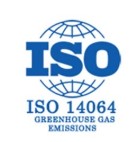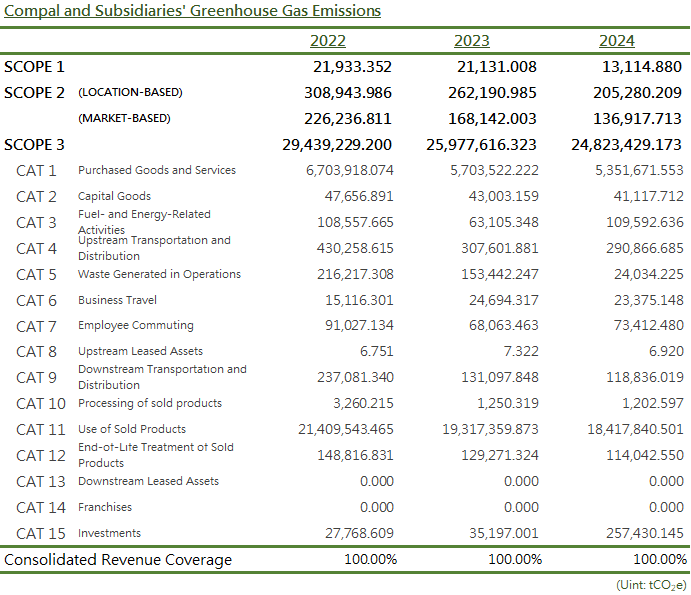Climate Action and GHG Management

Climate Change
Compal is continuing to adjust our production R&D direction, plant energy management, and ability to response to extreme climate to reduce the environmental impacts from climate change and business operations, and take advantage of the resultant business opportunities. The circular economy concept is being incorporated into product design from material selection, proper planning of the recovery and disassembly process, to the promotion of energy conservation and waste reduction initiatives at production locations, and increasing the use of renewable energy. These are all aimed at realizing the goals of mitigation, closing and shrinking the substance-energy cycle, and carbon emissions reduction throughout the product life cycle.
Greenhouse Gas Management
In accordance with the Financial Supervisory Commission’s (FSC) “Sustainable Development Action Plans for TWSE- and TPEx-Listed Companies,” enterprises are required to disclose the results of their greenhouse gas (GHG) inventories and reduction efforts, covering the entities within their consolidated financial statements.
Compal recognizes climate change as a significant challenge to business operations and a core concern for international supply chains. In 2024, Compal completed a comprehensive GHG inventory for all subsidiaries within its consolidated reporting scope, in compliance with ISO 14064-1: 2018. The results were verified by an independent third party, underscoring Compal’s commitment to information transparency and sustainability responsibility.
Goals and Progress
To strengthen internal decision-making and management effectiveness, Compal classifies inventory results into “individual company” and “consolidated reporting scope” categories for emissions monitoring and control. This approach reinforces autonomous carbon management across business units and ensures that all emission targets and actions are traceable and actionable. Furthermore, Compal has set its greenhouse gas reduction targets in alignment with Science Based Targets (SBT), which have been validated by SBTi.
These targets are defined within the boundary of the consolidated financial statements and outline clear short-, medium-, and long-term decarbonization pathways, moving toward the goal of net-zero emissions by 2050.
In consideration of differences in data availability and governance boundaries across emission scopes, Compal has established the following reduction pathways:
Scope 1 and Scope 2: Baseline year: 2019
o Baseline emissions: 369,033.14 tCO₂e
o Medium-term target (by 2030): 50.68% reduction from the baseline year.
o Long-term target (by 2050): 90% reduction from the baseline year, with residual emissions neutralized through carbon offsets.
Scope 3:
o Baseline year: 2021
o Medium-term target (by 2030): 25% reduction
o Long-term target (by 2050): 90% reduction
Compal will continue implementing greenhouse gas reduction projects across internal operations and the value chain, including equipment efficiency improvements, renewable energy adoption, low-carbon procurement promotion, and product carbon footprint assessments, to progressively achieve its RE100 and net-zero emissions goals by 2050.

Greenhouse Inventory
Since 2010, Compal has implemented ISO 14064-1 greenhouse gas inventories with external verifications, thus establishing a comprehensive greenhouse gas management system. To align with the latest international standards and scientific evidence, since 2023, Compal has fully adopted the Global Warming Potential (GWP) values from the IPCC’s Sixth Assessment Report (AR6 WG3) published in 2022. Fuel emission factors are primarily based on the IPCC 2006 Guidelines, along with government-announced energy consumption values for each operating site. Electricity emission factors are calculated using government-announced values for each operating site to enhance data accuracy and comparability.
Per the “GHG Protocol”, Scope 1 includes direct emissions from owned or controlled sources, Scope 2 includes indirect emissions from purchased electricity, and Scope 3 includes other indirect emissions (e.g., supply chain and product use phase).
■ Greenhouse Gas Emissions
For the entity-level reporting boundary, the following Scope 3 categories have been verified:
o Category 1: Purchased goods and services – indirect emissions from the life cycle of operational water use: 379.547 tCO₂e.
o Category 3: Fuel- and energy-related activities: 101,155.099 tCO₂e.

Greenhouse Gas Reduction
The nature of the industry means most of Compal’s GHG emissions are concentrated in externally purchased energy. To reduce GHG emissions in 2024, Compal procured 8,066.9 MWh of photovoltaic energy, 28,251.7 MWh of hydropower, and acquired 94,426 renewable energy certificates (RECs). Compal is there working hard to realize the target of GHG emissions reduction by 2030.
Internal Carbon Pricing, ICP
In response to intensified global climate change and the increasing implementation of carbon fees and trading mechanisms by governments, companies must proactively prepare for future carbon regulations to remain competitive. In 2024, Compal completed the planning of an Internal Carbon Pricing (ICP) mechanism. In its initial phase, a shadow pricing approach was adopted to assess external carbon-related risks and incorporate the concept of implicit price into internal carbon reduction cost evaluations.
Investment in Energy-Saving Equipment
In 2024, Compal invested a total of NT$3.39 million in energy-saving equipment at the Pingzhen plant in Taiwan. The investment was used to install an air conditioning energy monitoring platform and variable frequency devices to enhance electricity savings and carbon reduction. It is expected to save 316,542 kWh of electricity annually and reduce carbon emissions by 159 tons per year. The details are as follows:
1. Energy Management: An investment of NT$2.13 million was made to install an air conditioning energy monitoring platform, which includes multiple digital meters, thermometers, and flow meters. This measure is expected to reduce electricity consumption by 199,740 kWh annually and decrease carbon emissions by 101 tons per year.
2. New Energy-Saving Equipment: An investment of NT$1.26 million was made to install variable frequency controllers for the reflow oven exhaust system and the SMT process exhaust system. This measure is expected to save 116,802 kWh of electricity annually and reduce carbon emissions by 58 tons per year.